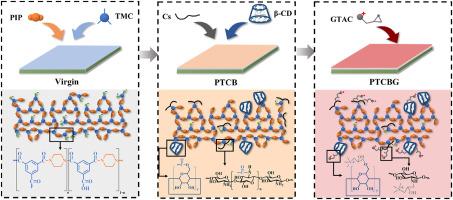A layer-by-layer-assembly modified semi-aromatic polyamide membrane with enhanced fouling resistance
IF 9
1区 工程技术
Q1 ENGINEERING, CHEMICAL
引用次数: 0
Abstract
Membrane fouling is a persistent challenge that hinders the widespread application of membrane technology for water treatment. This study introduced an innovative layer-by-layer-assembly approach (LBL), i.e., chitosan (Cs), β-cyclodextrin (β-CD), glycidyl trimethyl ammonium chloride (GTAC), to modify the semi-aromatic polyamide nanofiltration membrane to enhance the separation performance and fouling resistance. The results show that the LBL surface coating, i.e., amino group in Cs and/or hydroxyl group in β-CD reacted with the unhydrolyzed acyl chloride group in TMC and/or epoxy group in GTAC, partially neutralized the negatively charged membrane surface with enhanced hydrophilicity. The modified membrane (named as PTCBG) was on par with or even better than the leading commercial NF270 membrane in terms of permeability and selectivity (A value: 13.1–13.7 vs. 14.2–14.3 L·m−2·h−1·bar−1; A/B value: 9.2–46.9 vs. 3.1–8.8 bar-1, for rejection tests of typical divalent salts including CaCl2, MgCl2 and MgSO4). The flux decline rate (FDR) decreased significantly from 89% for virgin membrane to 29% for PTCBG membrane using dodecyl trimethyl ammonium bromide (DTAB) as a model foulant. The corresponding flux recovery rate (FRR) was 102%. It indicates the enhanced reversible anti-organic fouling property, which is attributed to the weakened hydrophobic and electrostatic attraction. The antibacterial rate of PTCBG relative to virgin membrane was 75% and 68% for Escherichia coli (E. coli) and Staphylococcus aureus (S. aureus). The FDR of PTCBG membrane exposed to E. coli and S. aureus was 20% and 51%, much lower than 35% and 65% for virgin one. It consistently reflected the enhanced biofouling resistance for PTCBG membrane, as a result of combined effects of weak adsorption and strong sterilization on bacteria, attributed to quaternary ammonium introduced by GTAC. This study provides an innovative and straight-forward strategy to fabricate polyamide membranes with good permeability/selectivity and excellent fouling resistance.

一种具有增强抗污性的逐层组装改性半芳香族聚酰胺膜
膜污染一直是阻碍膜技术在水处理中广泛应用的难题。采用壳聚糖(Cs)、β-环糊精(β-CD)、甘油三甲基氯化铵(GTAC)对半芳香族聚酰胺纳滤膜进行逐层组装,以提高膜的分离性能和抗污性能。结果表明,LBL表面涂层,即Cs中的氨基和/或β-CD中的羟基与TMC中未水解的酰氯和GTAC中的环氧基反应,部分中和了带负电的膜表面,增强了亲水性。改性膜(命名为PTCBG)在渗透性和选择性方面与领先的商用NF270膜相当甚至更好(A值:13.1-13.7 vs. 14.2-14.3 L·m−2·h−1·bar−1;A/B值:9.2-46.9 vs. 3.1-8.8 bar-1,用于典型的二价盐包括CaCl2, MgCl2和MgSO4)。以十二烷基三甲基溴化铵(DTAB)为模型污染物,PTCBG膜的通量下降率(FDR)从89%显著下降到29%。相应的通量回收率(FRR)为102%。结果表明,由于疏水和静电吸引力减弱,其可逆抗有机污染性能增强。PTCBG对大肠杆菌(E. coli)和金黄色葡萄球菌(S. aureus)的抗菌率分别为75%和68%。PTCBG膜暴露于大肠杆菌和金黄色葡萄球菌的FDR分别为20%和51%,远低于未接触PTCBG膜的35%和65%。这一致反映了PTCBG膜抗生物污染能力的增强,这是由于GTAC引入的季铵对细菌的弱吸附和强杀菌的综合作用。该研究提供了一种创新和直接的策略来制造具有良好渗透性/选择性和优异的抗污性的聚酰胺膜。
本文章由计算机程序翻译,如有差异,请以英文原文为准。
求助全文
约1分钟内获得全文
求助全文
来源期刊

Journal of Membrane Science
工程技术-高分子科学
CiteScore
17.10
自引率
17.90%
发文量
1031
审稿时长
2.5 months
期刊介绍:
The Journal of Membrane Science is a publication that focuses on membrane systems and is aimed at academic and industrial chemists, chemical engineers, materials scientists, and membranologists. It publishes original research and reviews on various aspects of membrane transport, membrane formation/structure, fouling, module/process design, and processes/applications. The journal primarily focuses on the structure, function, and performance of non-biological membranes but also includes papers that relate to biological membranes. The Journal of Membrane Science publishes Full Text Papers, State-of-the-Art Reviews, Letters to the Editor, and Perspectives.
 求助内容:
求助内容: 应助结果提醒方式:
应助结果提醒方式:


